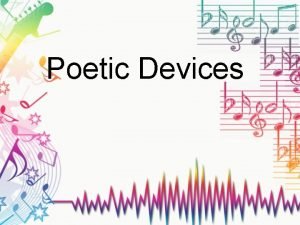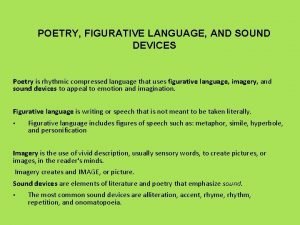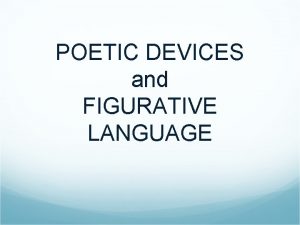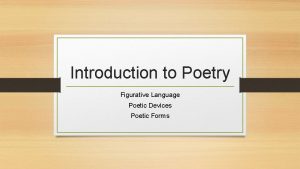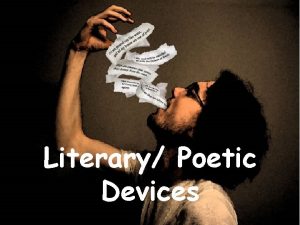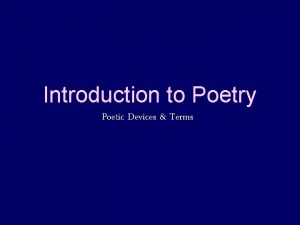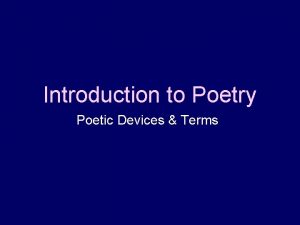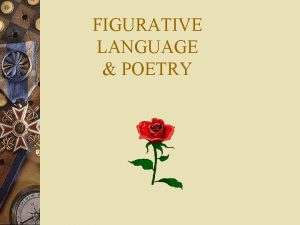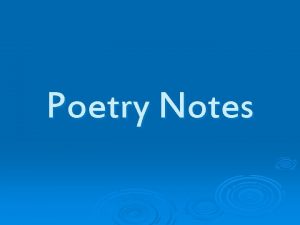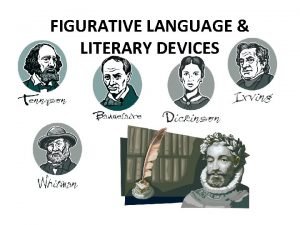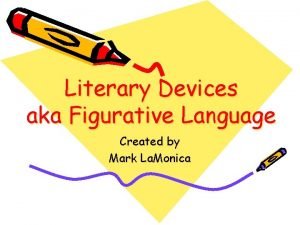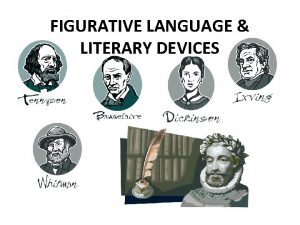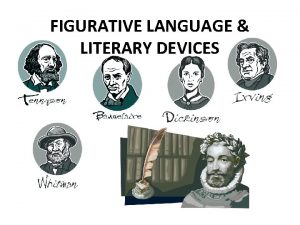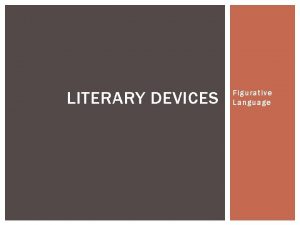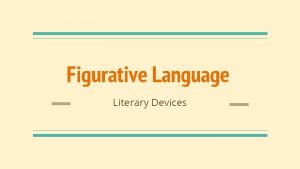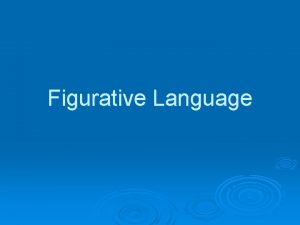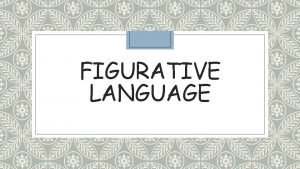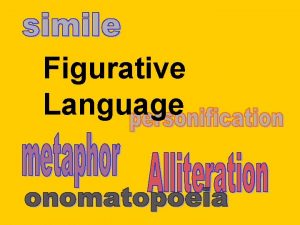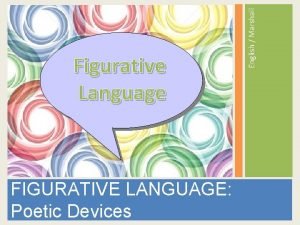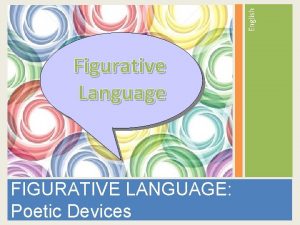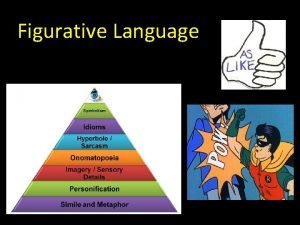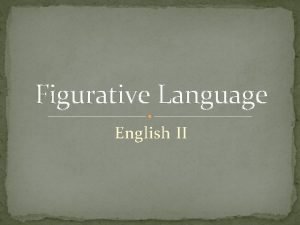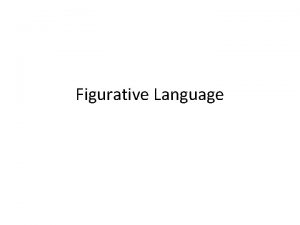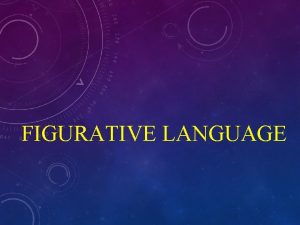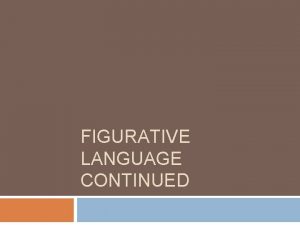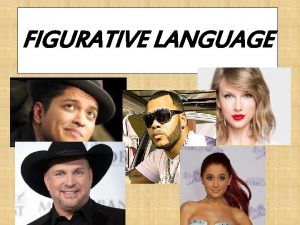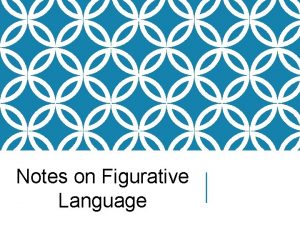Introduction to Poetry Figurative Language Poetic Devices Poetic
















- Slides: 16

Introduction to Poetry Figurative Language Poetic Devices Poetic Forms

What is Poetry? • Literary work in which the expression of feelings and ideas is given intensity by the use of distinctive style and rhythm; poems collectively or as a genre of literature. -Oxford English Dictionary • Poetry is about both meaning, usually figurative, and feeling. There are many forms and styles of poetry, but the components are usually the same.

Metaphor and Simile Metaphor • An implied comparison of two, usually unlike, things without the use of like or as. • ““Hope” is the thing with feathers” -Hope is the Thing with Feathers by Emily Dickinson Simile • A comparison of two things using the words like or as. • Her smile was as bright as the sun.

Personification • Personification is giving human or person like qualities to inanimate objects. This may make an object like a clock seem alive. • The hands stretched as far as they could and when the shortest reached the 12 every part of it shook and wailed.

Diction • Diction is the focus on the choice of words used within a poem. Word choice is very intentional in poetry, so each word was chosen for a specific reason that could bring different meaning to the poem as a whole depending on the connotations and denotations of word. • Denotation- The actual dictionary definition of a word. • Connotation- The meaning of a word to a specific group of people, a society, or in direct relation to a specific event.

Imagery • Imagery paints a picture with words. It uses the five senses: touch, sight, sound, smell, and taste. Poetry is a great format in which to use imagery for small sections or for a poem overall. • The overgrown grass danced in the warm breeze and the scent of rain hung in the air. The soft hum of electricity buzzed in the dark clouds that rolled in like ocean waves over a dry, cracked earth full of parched inhabitants.

Rhyme Scheme Rhyming poems are perhaps the most universally known within poetry due to the fact that this is what we see most as children (nursery rhymes, Dr. Seuss, etc. ) Rhyme scheme is the way we categorize or identify the specific pattern of rhyme in a poem. It uses the alphabet as the identifiers.

Rhythm/Meter • Rhythm is how the poem flows when read. Think of a piece of music, there is rhythm in it the same way there is rhythm in poetry. Often times the rhythm seems to come from the syllables or “beats” of the words. • Meter is the specific way in which we define the rhythm of a poem. Iambic pentameter is a meter used in poetry. Other examples of meter include:

Sonnets A Sonnet is a form of poetry that can be of Italian origin or English origin. More familiar to us is the English, or Shakespearean sonnet. Shakespeare did not invent sonnets, but he was very good at them an he wrote a good amount of the sonnets studied today. Sonnets are 14 lines with a rhyme scheme of ABAB CDCD EFEF GG

Sonnets and Iambic Pentameter Shakespearean sonnets use a meter/rhythm called Iambic Pentameter Iamb- a set of two syllables that pair up unstressed then stressed Pent- Five. Iambic Pentameter has five sets of iambs or ten syllables in an unstressed/stressed pattern.

Free Verse • Free verse is a form of poetry that has no set rhythm or rhyme scheme. There really are no rules about free verse. It allows the writer to have more creative choice in the format as well as the subject.

Villanelle • A villanelle, like a sonnet has particular rules to follow when formatting. • It consists of 19 lines divided into five stanzas of three lines each and a sixth stanza with four lines. • Rhyme scheme is ABA ABA ABAA • Meter is Iambic Pentameter, the same as Shakespearean Sonnet • Uses repetition and a possible refrain

Haiku • One of the shortest poetry forms consisting of only three lines and 17 syllables • 5 syllables in the first line, 7 syllables in the second line, and 5 syllables in the third line • Traditional haikus are written about nature.

BLACKOUT POETRY Blackout poetry takes writing that already exists and turns it into something brand new. Blackout poetry is achieved by marking out (usually in black) the words the poet does not want to create a unique poem. Visuals can also be added to blackout poetry, although they are not required.

Epic An epic poem is a very long poem that follows the triumphs and journey of a hero. Many Greek poems are epics, the most commonly known epics include The Oddysey, The Iliad, and Paradise Lost.

Concrete A concrete poem is a poem written in the shape of an object. A love poem could be in the shape of a heart, a poem about work could be in the shape of a hammer.
 Intro to poetry billy collins
Intro to poetry billy collins Figurative and sound devices
Figurative and sound devices Poetic devicea
Poetic devicea Define figurative language in poetry
Define figurative language in poetry The city is a concrete jungle figure of speech
The city is a concrete jungle figure of speech Literary technique examples
Literary technique examples Poetic devices examples
Poetic devices examples Poetic devices
Poetic devices A mighty creature is the germ
A mighty creature is the germ Poems figurative language
Poems figurative language Poems with sound devices and figurative language
Poems with sound devices and figurative language Figurative language elements of poetry
Figurative language elements of poetry Elements and techniques
Elements and techniques Literary devices figurative language
Literary devices figurative language Poem with sound devices and figurative language
Poem with sound devices and figurative language Poetic devices with examples
Poetic devices with examples Figurative language and literary devices
Figurative language and literary devices
